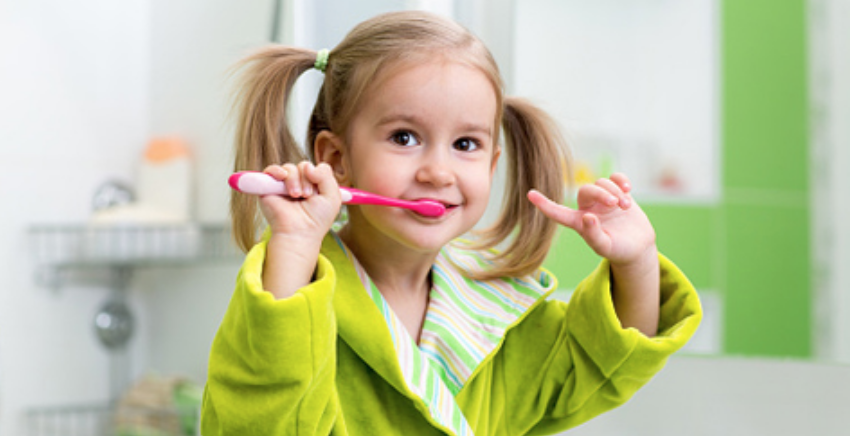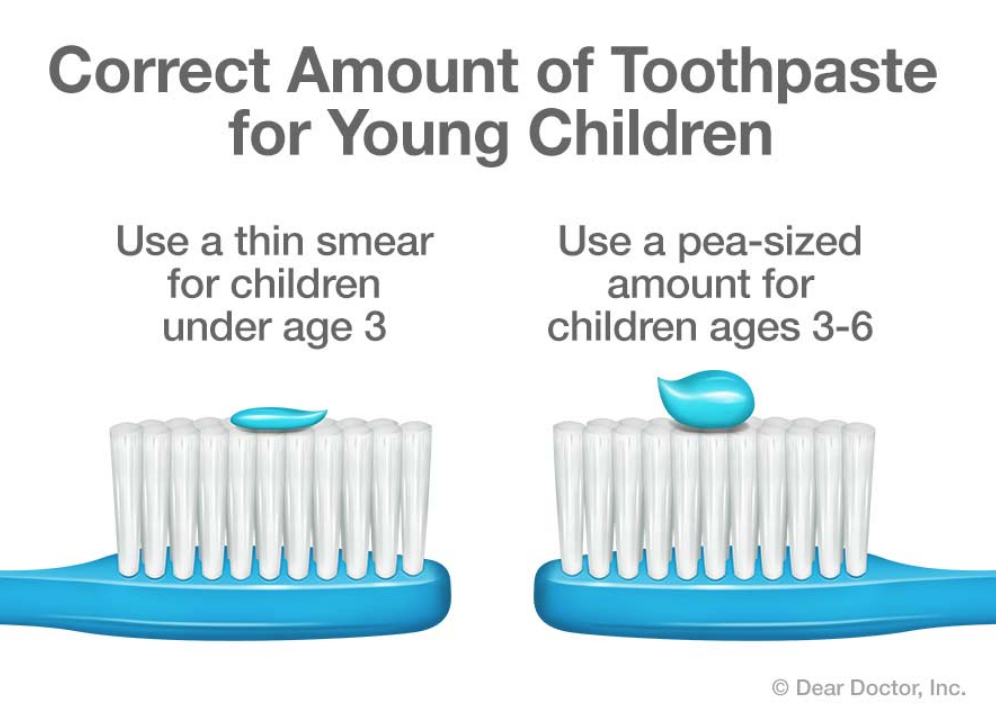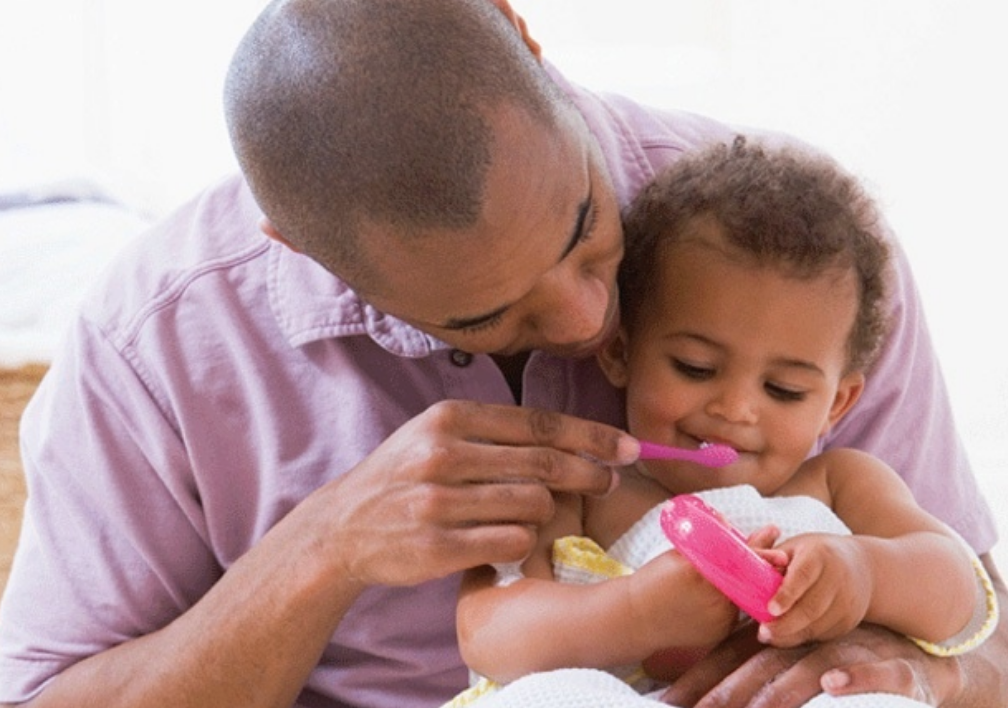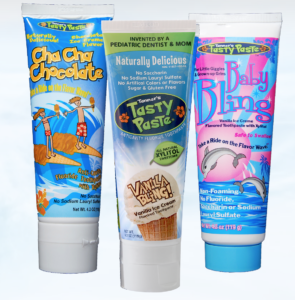The American Dental Association (ADA) recommends brushing your teeth with fluoridated toothpaste twice a day for two minutes. But is that really what we expect parents to do for their little ones every day? Ideally, yes, but let’s dive into some background info, recommendations, and tips for your child’s daily routine that might not be so overwhelming.
The physical act of brushing teeth is important for removing leftover food and plaque that builds up overnight or throughout the day. Nighttime brushing is particularly important so there isn’t sugar sitting on the teeth as they sleep. A lot of children are mouth breathers which dries out their mouth as they sleep, creating a wonderful environment for the bacteria in their mouth to prosper. Making sure the teeth are clean helps limit the bacteria’s access to sugar which helps prevent cavities.

Brushing in the morning is also important as we’re all familiar with morning breath and that fuzzy feeling on your teeth after a good night’s sleep. It’s important to remove the plaque that develops overnight, but brushing in the morning is also thought of as a second “dose” of fluoride toothpaste for the teeth. Dr. Erica and the American Academy of Pediatric Dentistry recommend using fluoride toothpaste from the moment a tooth erupts in the mouth. Brand new teeth act like sponges and absorb fluoride which makes the enamel stronger for the entire life of that tooth. The key is paying very close attention to how much toothpaste an infant or child is getting. For children under 3 years old, we recommend a small smear or grain of rice-sized amount of toothpaste. If you notice extra toothpaste in their mouth after brushing, you can wipe away the excess with a tissue or washcloth since toddlers aren’t reliable spitters. After age 3 when a child is better at spitting, you can start using a pea-sized amount of fluoride toothpaste.

In terms of the amount of time spent brushing, this is quite variable in young children. If you can get your 2-year-old to sit still for two minutes and let you brush their teeth, that’s great! But it’s likely your toddler won’t be so cooperative and since they have less teeth than adults anyway, don’t stress out if you can’t get a full two minutes. We focus on making sure toothbrushing is a part of a child’s routine twice a day when they’re very young, but the actual amount of time spent brushing can be adjusted as they age. Try to pass the toothbrush over all of the surfaces of each tooth a few times, using gentle circular motions.
Many toddlers are quite independent and will insist on doing the brushing themselves which can be a tough daily battle for parents. We encourage toddlers to “share” the job of brushing with their parents so they have a turn brushing first, with an adult finishing the brushing. Our mantra is if you don’t trust your child to do a good job washing your floors, they shouldn’t be trusted to brush their teeth properly. Even adolescent patients need adult help, or at least adult supervision, to make sure they are doing a good job brushing. You’ll find toddlers do a good job brushing their front teeth, but might completely ignore the molars.

But let’s face it, some toddlers just HATE having their teeth brushed. You can try every flavor toothpaste, every manual and electric toothbrush on the market, singing, even brushing apps on their tablets, but they cry and fight every time. Unfortunately we don’t have a magical solution, but we always encourage parents to “keep fighting the fight”. Some kids hate getting their diaper changed or going to bed at night, but you do it anyway because it’s important for their health. Same should be though of brushing! It’s so important to set up a child’s routine early on so they realize brushing their teeth is just a part of their daily life that can’t be ignored.
If your child is not a fan of brushing, we can at least try to offer a few suggestions to make this process easier for your family. Don’t think that toothbrushing needs to be limited to the bathroom sink. Try brushing your child’s teeth in their highchair, the changing table, on the couch or bed, the bath, even in front of a TV or tablet if needed. If there are two adults at home, make it a team effort so one adult can hold the child still while the other can get good access with the toothbrush. Sometimes having two toothbrushes can be helpful so that one is used to help keep the child’s mouth open and the other does the scrubbing. Give your child your toothbrush so they can try to brush your teeth while you brush theirs. Slipping your finger into your child’s mouth carefully to pull their upper lip away is helpful to get access to the top teeth and gums that can otherwise be firmly covered by a tight-lipped child. Stand behind your child to brush their teeth, using one arm to “bear hug” them and the other to brush your teeth (this is actually a great way to brush for them because you end up mimicking the posture that you use to brush your own teeth). As we say – keep fighting the fight at home, daily toothbrushing is extremely important for your child’s wellbeing and we promise they will eventually learn to tolerate and maybe even enjoy brushing as they grow up in our practice!


Here are a few suggestions for brushing that we often mention in our office:
- Tom’s of Maine Silly Strawberry Toothpaste – a mild flavored fruit toothpaste that is popular among children who are picky about flavors
- Tanner’s Tasty Paste – available in chocolate and vanilla, this is another toothpaste we often recommend for children who don’t like the other fruity, overly sweet flavored toothpastes available in stores
- Disney Magic Timer App – this app can make brushing more fun by playing videos and music while your child brushes and rewards them for their daily brushing with cute virtual stickers
- Daily Brushing Chart – there are many charts available online that can be downloaded and printed to encourage kids to brush twice a day by earning a sticker each time and maybe even a prize too!
And here are some great videos demonstrating techniques for babies and toddlers:
- How to Brush a One Year Old’s Teeth
- How to Brush a Two Year Old’s Teeth
- How to Brush a Three Year Old’s Teeth
– Dr. Erica Pitera
Sweet Tooth Pediatric Dentistry
583 Saybrook Road
Middletown, CT 06457
(860) 347-4681
www.sweettoothkids.com
